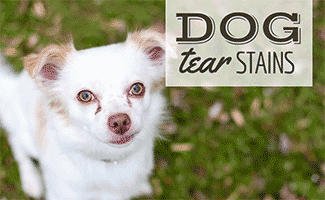
To keep the lights on, we receive affiliate commissions via some of our links. Our review process.

If your furry friend often has unsightly reddish-brown staining under her eyes, you’re likely wondering what you can do to get rid of these stains (technically called tear stains). Fortunately, you have several at-home solutions, but removing tear stains in dogs and preventing them from coming back can take some work to find the best regimen and products for your pup. We’ll help you understand why dogs get tear stains in the first place, possible health concerns, and ways to clean, minimize, and even prevent your dog’s tear stains.
What Causes Tear Stains In Dogs?
Contents
Many people think that overproduction of tears causes tear stains, but that’s not entirely accurate, say experts at MedVet. Excessive tears most certainly exacerbate tear staining, but it’s the naturally occurring molecule porphyrin that causes the reddish-brown discoloration under a dog’s eyes.
Porphyrins are waste products produced when the body breaks down iron, and they’re excreted through tears, urine, saliva, and the digestive system in dogs. It’s the iron in porphyrin that’s responsible for the reddish coloring. While all dogs have porphyrin in their tears, some dogs have more than others. Porphyrin staining can be a normal cosmetic issue for many dogs rather than a health concern.
Possible Medical Concerns
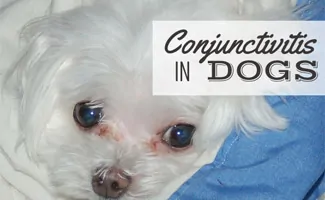
However, some health issues cause watery eyes and the resulting tear stains. When you first notice tear stains on your dog, it’s important to see your veterinarian and make sure she’s not suffering from a possible underlying health problem. These can include:
- Glaucoma
- Conjunctivitis
- Eye infections
- Ear infections
- Ingrown eyelashes
- Allergies
Eye Structure & Genetics

Some dogs have structural abnormalities in their eyes that contribute to excessive tearing and hence tear stains. These can include large tear glands, blocked tear ducts, narrow tear ducts, etc. A common congenital condition called imperforate punctum results in underdeveloped tear ducts in some breeds, including Cocker Spaniels, Poodles, Golden Retrievers, and Labradors.
And some dog breeds (particularly brachycephalic dogs) have flat faces and shallow eye sockets that can cause chronically watery eyes and tear stains. These include Boxers, Boston Terriers, Bulldogs, Lhasa Apsos, Maltese, Pugs, Pekingese, and Shih Tzus.
Dogs with long hair on their faces are also more likely to develop tear stains because the hair can grow inward and get into the eyes, causing irritation. Most prone are Schnauzers, Cocker Spaniels, Dachshunds, Pekingese, Poodles, Cairn Terriers, and West Highland Terriers. In these breeds especially, it’s important to keep facial hair trimmed as short as possible to help prevent tear stains.
Signs Of Tear Stains
Tear stains are a reddish discoloration on the hair under a dog’s eyes. Sometimes there’s also a discharge from the eyes but not always. Tear stains are much easier to spot on light-colored dogs. In dark-haired dogs, the most obvious sign is usually constantly wet fur under the eyes.
If your dog’s stains are brown instead of red, she could have a yeast infection, which often can have a foul odor. Chronic wet fur can be a breeding ground for yeast to form, creating a skin infection. If your dog’s tear stains are brown, you should see your veterinarian for treatment to clear up the infection.
How To Get Rid Of Tear Stains On Dogs
Cleaning existing tear stains is just one part of ongoing home treatment and maintenance you can do to help manage your pup’s tear staining. These products and home remedies have varying success rates depending on each dog, so you may need to go through some trial and error to find what works best for your pup. Be sure to check with your vet before administering any home treatment to ensure safety.
Best Dog Tear Stain Removers
First, we’ll give you our top picks of products on the market you can use to help remove those unsightly tear stains. Keep in mind that it may take some time to completely remove the stains, particularly if your dog has heavy staining.
TropiClean SPA Tear Stain Remover for Pets
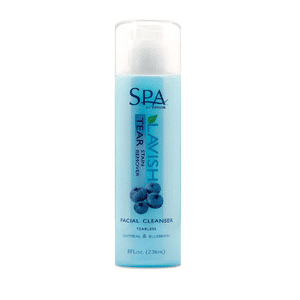
SPA Tear Stain Remover gets excellent reviews from pet parents and groomers. This USA-made solution contains coconut cleanser, vitamin E, oatmeal, white tea, and other all-natural ingredients. Simply put a few drops on your finger or a cotton ball and gently scrub it onto your dog’s stains, leave on for about three minutes, and rinse. It also has a pleasant vanilla and blueberry scent.
Price
Angel’s Eyes Gentle Tear Stain Wipes
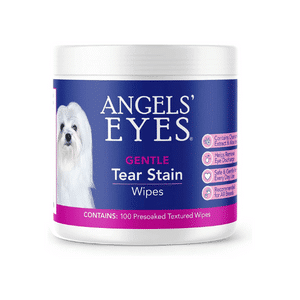
Angel’s Eyes wipes are a popular choice for many owners because they’re so easy to use. The wipes are pre-soaked and textured and require no rinsing after you use them. They’re also helpful in removing dried mucus and secretions. This solution is gentle on the fur and skin and contains no bleach, antibiotics, or harsh chemicals. They’re also made in the USA.
Price
Eye Envy Tear Stain Remover Powder
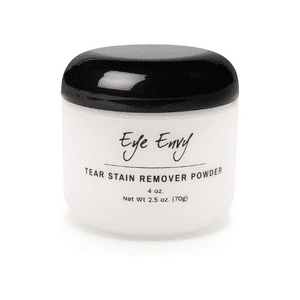
Many pet parents swear by this product. It’s an all-natural powder that you can apply to your dog’s tear stains after cleaning them (many say using a toothbrush to apply the powder works best). Although the powder is part of Eye Envy’s three-step tear stain removal kit, many people choose to only use the powder. It contains herbs such as goldenseal, echinacea, and eyebright as well as boric crystals to cleanse and keep hair dry. Also made in the USA, it’s cruelty-free and contains no parabens, peroxide, bleach, steroids, antibiotics, or other harmful agents.
Price
Home Remedies To Clean Tear Stains
If you’re wondering how to remove dog tear stains naturally with a home remedy, you have a few options. You can use these to clean tear stains every day, but make sure you avoid getting them in your dog’s eyes.
- Mix one part hydrogen peroxide with 10 parts water.
- Boil one tablespoon of boric acid powder in one cup of distilled water (keep refrigerated).
- Contact lens solution includes boric acid that oxidizes the iron in porphyrins and could help to lighten stains (but DO NOT use in the eyes).
- Dab cornstarch over the stains to help absorb moisture.
Tips To Help Reduce Or Prevent Tear Stains
Other things you can do at home to help minimize tear staining include:
- Keep the hair around your dog’s eyes and nose trimmed short.
- Clean your pup’s face every day (baby shampoo and a warm washcloth work well) and dry with a towel.
- Clean tear stains daily using one of the products or home remedies above and dry the fur.
- Flush out your dog’s eyes with a dog-friendly saline eye wash.
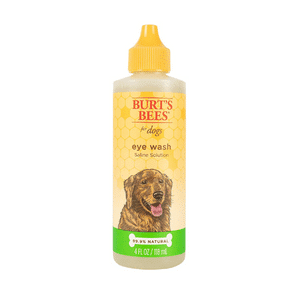
How To Reduce Porphyrin In Dogs
Since an excessive amount of porphyrin is a primary cause of staining, are there ways to reduce porphyrin in dogs? Yes, some owners find these dietary changes can help.
- Give your pup purified, distilled water rather than tap or well water. Tap and well water can contain iron and other minerals that may make staining worse.
- Switching to dog food that doesn’t contain beef may also help reduce porphyrin in dogs since red meat is high in iron.
A Healthier Diet Can Make A Big Difference

In addition to removing red meat from your dog’s diet, switching to high-quality dog food that’s low in carbohydrate fillers has been shown to help with tear staining. Such ingredients as wheat, corn, meals, by-products, and artificial preservatives can cause inflammation in the eyes, particularly if your pup has allergies. We recommend a limited-ingredient, all-natural dog food. Some owners find grain-free dog food helps as well.
Some Find Dietary Supplements Help
Some pet parents find that adding a teaspoon of organic apple cider vinegar to your dog’s water or food every day can help minimize tear stains. Others have found success with the use of daily supplements formulated to help with tear staining. We recommend two all-natural USA-made products, NaturVet Tear Stain Supplement and ThomasPet’s I Stain. Just keep in mind that it can take up to two months of daily use to see results.

Are Antibiotics Effective?
Antibiotics such as tylosin or tetracycline can be effective in reducing tear staining in some dogs, but there’s controversy about their use for purely cosmetic reasons. Why? As with humans, there’s concern about dogs building up a resistance to antibiotics, according to Innovative Veterinary Journal and other experts. And long-term antibiotic use isn’t recommended by veterinarians.
Eye Problems In Dogs
If you’re concerned that your pup has an eye condition that could be contributing to her tear stains, be sure to check out our article on eye conditions that cause red eyes in dogs. You may also want to see if your dog has allergies that could be exacerbating tear stains. And always consult your vet about any health concerns you have with your pup.
Tagged With: Eyes